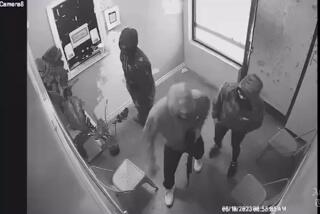L.A. County Scrutinizes Courtroom Safety
Every workday in Los Angeles County, almost 2,000 people on trial for crimes such as murder, rape, drug offenses and robbery are taken from jail and bused to a date with justice.
Vehicles fan out to 52 courthouses, from Lancaster to Long Beach, and carefully turn the inmates over to 1,252 sheriffâs deputies and courtroom bailiffs.
Most days pass without incident, in part because of an elaborate courthouse security system designed to keep inmates safely away from the roughly 10,000 prospective jurors who are similarly called to appear.
But the slashing of a lawyer on March 14 in a San Fernando courtroom by the gang member she was defending, and the shootings of three people in an Atlanta courthouse a few days earlier serve as a reminder that no security scheme is perfect.
âWe are as confident as you can be in a situation where you can never say ânever,â â Allan Parachini, public information director for the Los Angeles County Superior Court, said of the countyâs nearly 600 courtrooms. âThe situation in society involving weapons and violence is too deep-seated for anyone to make any guarantees.â
âPhysical violence, while unusual, is not rare,â said Donald Wager, a longtime defense attorney and former president of the Los Angeles Criminal Courts Bar Assn. Wager said he once saw a client overturn a courtroom table in a fit of rage.
On Tuesday, the Los Angeles County Sheriffâs Department, which runs the jails and is responsible for court security, was called before the county Board of Supervisors in response to the courtroom slashing. Department officials told supervisors that they were conducting a security survey of all courthouse lockups or inmate holding areas, increasing the frequency of physical searches in those areas and purchasing hand-held metal detectors to screen defendants before they enter courthouses.
Razors have been found in courtrooms before. In one case last year, a criminal defendant smuggled a razor blade into a downtown Los Angeles courtroom, slashed himself in the neck and then splashed his blood on his attorney.
âI still donât know how he got the razor blade into the courtroom. I would like to see tougher screening,â said the lawyer, David Diamond.
The screening system starts in one of the countyâs seven jails, which currently hold about 17,000 inmates. Before they leave the jails, their identification wristbands are scanned.
Then they are shackled together in groups of two or four and put on a sheriffâs department bus or van with a guard and a driver, who are both armed, said Capt. Ricardo Cotwright, who oversees security for the San Fernando court and other courts in western Los Angeles County.
Upon arriving at the courthouse, the sheriffâs vehicle pulls into an enclosed area known as a âsally port,â where the defendants are unloaded and escorted to a holding area inside the courthouse.
When itâs time for their court appearance, defendants are escorted by deputies, who are not armed so that defendants canât seize their weapons.
In a typical trial in criminal court, at least one bailiff is stationed close to the defendant, said Sgt. Steve Wheatcroft, head of a unit of deputies that provides security for judges outside the courtroom.
The judge is separated from the prosecution and defense tables by an area called the âwell,â a feature, he said, derived from centuries-old English judicial tradition, in which ânobody could be within a swordâs length of the judge.â
The judge is also seated higher than the rest of the court, Wheatcroft added, not only to convey authority, but to provide a physical barrier to protect against potential attackers.
As for the jury, the risk of being injured by a defendant is low, said Mike Gennaco, an attorney in charge of the Office of Independent Review, a civilian watchdog body that monitors the conduct of the Sheriffâs Department for the county.
Erik Morales, the 26-year-old gang member who slashed the arm of his attorney, Linda Wieder, in San Fernando last week, was classified a âK-10,â the highest security level designation for a defendant.
âIâm aware of no instances in which jurors have been harmed [in court] as a result of a defendant,â Gennaco said. âIt would have been really difficult for [Morales] to have reached out to others.â
The orange jumpsuit-clad K-10s, who account for about 2% to 3% of the countyâs inmates, are held separately from other defendants at all times while in custody because they are considered likely to escape, have violent tendencies or have gang affiliations that make them dangerous to other inmates, said Chief Richard Martinez, head of the sheriffâs court services division.
At the meeting with county supervisors, Martinez said that Morales went through the customary checks for high-security inmates, including being held in a separate cell at the courthouse that had been searched for weapons, and being subjected to a physical search and a thorough inspection of his clothing. Martinez said the defendant had carried the razor into the courthouse in his pocket, hid it somewhere in his cell before he was searched and retrieved it before entering the courtroom.
In the days following the incident, and until the jury returned guilty verdicts on both murder counts on March 17, Martinez said Morales had appeared in court in a âsafety chair,â to which his hands and feet were strapped.
Cotwright sought to allay fears about security. âThis is not an incident that occurs frequently,â he said.
For âthe public, the jurors, the workers, there should not be a hesitancy to come inside the court buildings.â
Times staff writer Caitlin Liu contributed to this report.
More to Read
Sign up for Essential California
The most important California stories and recommendations in your inbox every morning.
You may occasionally receive promotional content from the Los Angeles Times.










